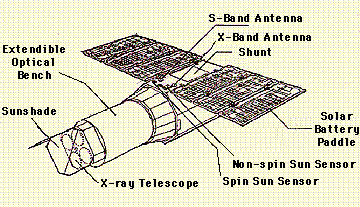|
|
The ASCA mission

The Advanced Satellite for Cosmology and Astrophysics (ASCA; renamed from
Astro D when launched) is Japan's fourth cosmic X-ray astronomy
mission, and the second for which the United States is providing part
of the scientific payload. The satellite was successfully launched
February 20, 1993. The first eight months of the ASCA mission were
devoted to performance verification. Having established the quality of
performance of all the instruments, ASCA changed to a "guest
observer" satellite for the remainder of the mission. In this phase,
the observing program is open to astronomers based at Japanese and US
institutions, as well as those who are located in member states of the
European Space Agency.

Instrumentation

ASCA carries four large-area
X-ray telescopes (http://heasarc.gsfc.nasa.gov/docs/asca/asca_xrt.html). At the focus of two
of the telescopes is a Gas Imaging Spectrometer
(GIS) (http://heasarc.gsfc.nasa.gov/docs/asca/asca_gis.html), while a Solid-state Imaging
Spectrometer (SIS) (http://heasarc.gsfc.nasa.gov/docs/asca/asca_sis.html) is at the focus
of the other two. The GIS is a gas imaging
scintillation proportional counter and is based on the GSPC that flew
on the second Japanese X-ray astronomy mission,
Tenma. The two SIS
instruments are identical Charge Coupled Device (CCD) cameras and were
provided by a hardware team from MIT, Osaka University, and ISAS.
| CCDs | IGSPCs |
|---|
| Developer |
NASA/MIT
| ISAS |
|---|
| Energy Range |
0.3 to 10 keV
| 0.7 to 1.2 keV |
|---|
| Spectral Resolution |
2
| 8 |
|---|
| ALIGN="left">Spatial Resolution |
2.9 arcminutes
| 2.9 arcminutes |
|---|
| Time Resolution |
1 - 10 seconds
| 61 microseconds |
|---|
| Fields of View |
22 x 22 arcminutes
| 30 arcminute diameter |
|---|
| Detector Length |
303 mm
| 580 mm |
|---|
| Detector Diameter |
165 mm
| 150 mm |
|---|

|
